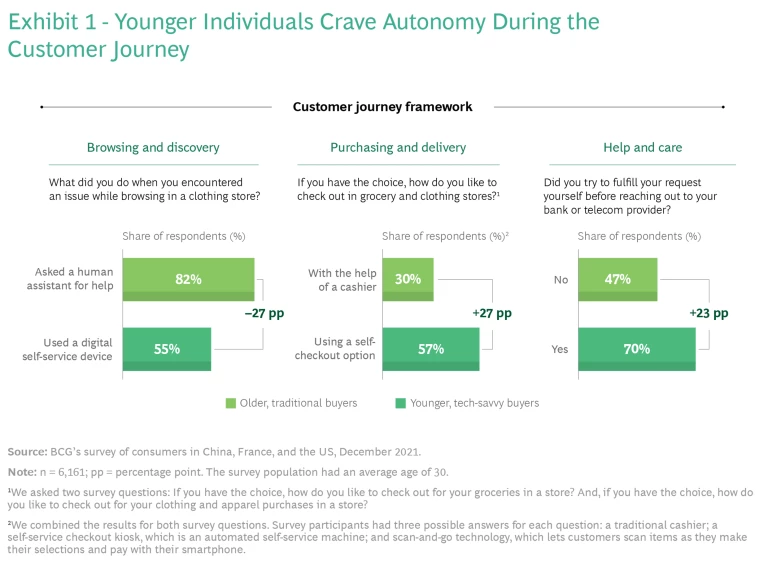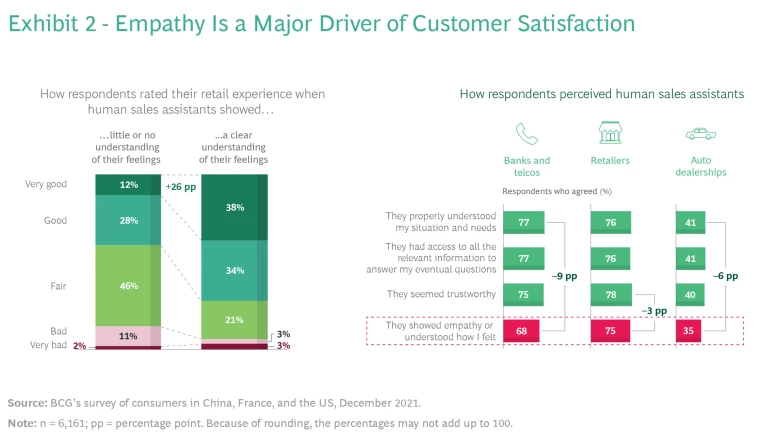Retailers and service providers should rethink where and how they deploy their sales agents. Data shows that current approaches aren’t delivering the experiences that consumers prefer.
Companies have long operated under the assumption that buyers want a human-led experience. But more than 6,000 consumers worldwide have flipped that conventional thinking on its head. A large-scale survey by Boston Consulting Group found that tech-savvy millennials and Gen-Z shoppers are comfortable navigating the purchasing journey independently, but when they need help, they prefer digital assistants to humans in most instances.
With spending among younger demographics expected to reach roughly $3 trillion by 2030 in the US retail sector alone, this finding presents a wake-up call and an opportunity for businesses across industries. To meet the needs of key audiences, companies will need to ramp up their digital engagement and rethink how they deploy their human talent.
Survey Respondents Prove Conventional Wisdom Wrong
We asked 6,200 individuals in China, France, and the US to comment on their purchasing experiences. Our research, conducted at the end of 2021, covered 10,000 customer journeys that encompassed buying groceries, shopping for a car, engaging with a bank, talking to a telecom provider, and picking out clothing.
We were particularly interested in understanding the value that customers ascribe to the digital and human sales agents they encounter in the buying process. Is one more effective than the other? Our hypothesis was that buyers would prefer people-led interactions. We thought that they may find bots clunky and see the rise in digital self-service interactions as self-serving on the part of the business—perhaps an effort to shift the “work” of purchasing to the customer.
We were wrong on nearly all counts. Older buyers, aged 55 and over, who rated themselves as not very technologically savvy, prefer traditional human-centered interactions. For younger participants, roughly aged 45 and under and tech savvy, digital self-service interactions are not just satisfactory but the preferred means of engagement in all but the most complex or high-stakes situations. And that dynamic proved especially true among millennials and their Gen-Z counterparts.
Let’s look at what we learned in more detail.
Younger individuals crave autonomy. When it comes to interacting with service providers, 70% of younger buyers said that they try to use bots and self-service tools and avoid dealing with sales agents. This preference held true whether they were shopping in clothing boutiques and grocery stores or purchasing cars. In retail settings, for instance, 57% of younger buyers said that they favor self-service scan-and-go kiosks over cashiers when given the choice. (See Exhibit 1.)
Younger buyers are also quick to try and solve problems on their own before reaching out to a salesperson. When shopping for clothing, for example, only about half of younger buyers, compared with 82% of older ones, said that they reach out to human assistants when they encounter an issue. The desire for autonomy carries over to big-ticket purchases, such as buying a car. Close to one-third of younger buyers said that they would like to peruse an auto dealer’s showroom on their own first and then speak to an advisor if they have questions.
In fact, the preference for the digital do-it-yourself approach runs so strong that some millennials and Gen-Z consumers will go it alone even if doing so takes them slightly longer to complete a task or resolve a question. This attitude makes sense. Younger buyers have grown up with technology. If they don’t know an answer to something, they look online. If they want to reach someone quickly, they text them. If they want to watch a movie, they stream it. This behavior naturally carries over to when they shop.
Bots are competent sales aides. Tools to enable digital engagement have gotten a lot better. Ten years ago, the typical bot interaction resembled the stuff of movies, and not in a good way. Conversations were stilted and robotic sounding, the range of addressable queries limited, and the exchanges prone to error, sometimes laughably so. But bots have shed their reputation for being clunky interfaces as their natural-language processing abilities have improved, and some are beginning to rival humans in key performance areas.
Bots have shed their reputation for being clunky interfaces.
Sixty percent of surveyed buyers who “conversed” with bots when they browsed for clothing, groceries, and other consumables said that these digital assistants demonstrated an appropriate understanding of their needs. Notably, when the buyers rated human assistants and bots, the former outperformed by only 17 percentage points in this dimension. Similarly, 61% of shoppers said that bots came across as trustworthy, compared with 76% of buyers who said the same for human sales and support agents—a difference of just 15 percentage points. And in bank and telecom settings, where digital agents are most actively employed, chatbots and voice-enabled bots earned an average satisfaction rating of 3.9 on a 5-point scale across all age clusters.
As elsewhere, younger buyers are most enthusiastic about technology-assisted tools for shopping. For example, younger city dwellers said that they are more likely to rate their experience with a service provider as good or very good if it involved a bot. Many also find engaging with robots to be fun. For example, roughly two-thirds of younger Chinese buyers noted that they’d welcome the opportunity to interact with physical robots when browsing the aisles of clothing and convenience stores.
But our research shows that human assistance is still vital. Buyers across all demographics made clear that they favor direct human interaction over digital interaction when a purchase or issue is urgent or complex. Both scenarios require immediate access to a reliable trove of expertise. And in both scenarios, the most efficient way to gain knowledge and ask and answer questions is by having a one-on-one conversation with an individual.
Inefficiency and indifference are experience killers. Companies need to show that they respect a customer’s time and provide experiences that demonstrate caring and empathy.
Every minute of wait time lowers satisfaction. When asked to consider past shopping interactions, for example, 39% of buyers who were served right away rated their experience as excellent, compared with 23% of those who waited for two to five minutes and just 17% of those who waited for five minutes or longer. Being placed on hold when calling a customer-service agent can be even more grating. Seventy-five percent of customers who got through to an agent at their bank or telecom provider right away rated their experience as good. But less than half (48%) of those who waited for up to ten minutes gave the same rating.
Even worse are sloppy transfers. Being passed from agent to agent is an experience killer no matter whether the engagement is with a human, a bot, or a combination of the two. A poor transfer not only wastes time, it signals a failed interaction, since it means the original sales liaison was unable to fulfill the request. And invariably, customers are left to pick up the pieces, repeating basic information, bringing the new agent up to speed, and providing continuity from one conversation to the next. Close to three-quarters (72%) of survey respondents who were redirected to another bank or telecom agent said that they had to explain their issue all over again. And roughly one-third of respondents who were passed from agent to agent rated their experience as bad or very bad.
Conveying caring and empathy is equally important—and it can make the difference between a good customer experience rating and a very good one. (See Exhibit 2.) Surprisingly, human sales assistants performed worse in these areas than in any other service dimension, including demonstrating understanding or trustworthiness. This pattern of low performance held true across the industry segments that we surveyed.
Winners Will Act on the Message
Consumers have provided a crisp distillation of what it will take to win them over. Companies now have an opportunity to act on those insights. We expect the following steps will be pivotal to becoming a customer experience leader. In fact, some companies are well on their way.
Put autonomy at the center of the browsing and discovery stage of the customer experience. Winning organizations will invest in digital processes that support easy searching, nimble comparison shopping, and tailored recommendations.
For example, Ford and Alibaba have developed a vending machine powered by artificial intelligence (AI) that dispenses cars in China. A kiosk authenticates an individual’s identification and runs a background check. Then the individual selects a car to test drive. Minutes later, the desired vehicle rolls out of a mechanically operated storage facility.
Similarly, Porsche and BMW have shown that a digital-first approach can be successful even with products that command six-figures. Both have rolled out digital build-your-own-car tools that give consumers the ability to learn about various features and options, select those that fit their preferences and budget, and submit their order online. Customers can then choose to have their cars delivered straight to their home or go to an experience center where trained representatives guide buyers through the ins and outs of their new vehicle. This approach underscores the potential of enabling an autonomous path for consumers who are comfortable with digital interactions, while still offering the human touch at key moments.
Make the purchasing and delivery stage of the customer experience fast and efficient. High-performing organizations will be zealous about shaving seconds off every process, scouring customer experiences for points of friction, reducing and streamlining handoffs, and closely tracking time thresholds for different interactions.
For instance, many stores have some form of basic self-checkout service in which customers pass items over a bar code scanner. But others are raising the bar quickly. In some Uniqlo and Decathlon stores, radio frequency tags allow machines to scan a customer’s entire basket in one pass. At the top end of the maturity curve is the checkout process at Amazon Go, which integrates and automates the entire purchasing experience, allowing customers to walk into a store, select what they need, and exit without using a cashier or kiosk.
Allow human agents to shine when complexity is high and advice is most needed. As organizations scale their digital self-service tools and automate manual tasks, they should reassign the employees who performed these tasks to innovative and high-value forms of engagement.
Instead of conventional high-pressure customer service settings in which human agents read from scripts and deliver generic service to a mass audience of callers, top-performing organizations will enable their customer service staff to shine as experts, supported by AI tools and digital dashboards that put customer insights within ready grasp.
Frontline interactions will also be redesigned to allow digital tools to manage routine needs and enable personnel to provide tailored counsel. The shift will create more exciting opportunities for employees and greater value for customers. Bank tellers, for instance, can do more than simply process transactions. Equipped with the right analytics, they can help customers choose from a variety of savings products or credit card offers on the basis of their life stage and goals.
The shift to digital tools will create more exciting opportunities for employees and greater value for customers.
In these ways, leading companies will reserve human interactions for the stages of the customer experience that present complexity and high-stakes considerations and use human agents in settings where they can excel.
Embed empathy in all human and digital interactions. Customer service organizations have an opportunity to become much better at discerning customers’ emotions, intuiting needs, and providing the right information in a way that conveys empathy by using AI and advanced analytics.
Affective AI, for example, can recognize and mimic trillions of human emotions. This technology monitors phone calls or chat interactions for cues that signal a shift in a customer’s emotions—tracking changes down to a tenth of a second in some cases. Then it shares that information, prompting human advisors and bots supported by these systems to adjust facial or audio expressions and adapt content and conversations appropriately. These systems can also predict a customer’s intent so that human and digital agents can be ready to reply with an appropriate suggestion or offer.
Other types of specialized analytics can help organizations perform triage, routing customers with more complex needs to support agents with relevant expertise. For example, a system that senses that a customer is annoyed can direct that individual to an agent who has specific training in de-escalation to help resolve the customer’s problem in a constructive fashion.
Digitization is transforming the buying process, enabling consumers to navigate the purchasing journey on their own terms. Human assistance will still be essential, but organizations aren’t putting these vital resources to the best use today. Many companies still treat sales agents as cogs when they can offer so much more and when technologies can handle functionary roles more than adequately.
Leading customer experience organizations won’t rest idly. They’ll be bold enough to redesign journeys and interactions so that human and digital resources can be engaged when and where each can add the most value. In doing so, leading companies will satisfy and win customers—today and tomorrow.









